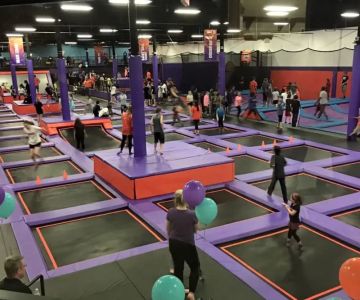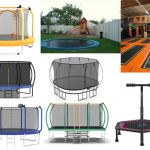- 1-Understanding-the-Importance-of-Safety-Certifications
- 2-Key-Safety-Certifications-for-Trampoline-Parks
- 3-How-Certifications-Impact-Visitor-Safety
- 4-Common-Misconceptions-about-Trampoline-Safety
- 5-Real-World-Examples-Highlighting-Safety-Importance
- 6-Choosing-a-Trampoline-Park-with-Confidence
1. Understanding the Importance of Safety Certifications
Safety certifications are essential indicators that a trampoline park adheres to strict industry standards and regulations. These certifications help ensure that equipment is properly installed, maintained, and inspected regularly, reducing the risk of injury to visitors.
Given the high-energy nature of trampoline parks, where users jump, flip, and perform dynamic moves, prioritizing safety through recognized certifications is critical for both families and individual thrill-seekers.
1.1 Why Certifications Matter More Than Ever
With increasing popularity, trampoline parks have seen more visitors and, unfortunately, some safety incidents. Certified parks show a commitment to safety protocols that protect their guests and provide peace of mind.
2. Key Safety Certifications for Trampoline Parks
Several well-regarded certifications and standards indicate a trampoline park’s dedication to safety:
2.1 ASTM International Standards
ASTM provides safety standards for trampoline design, installation, and operation. Parks meeting ASTM standards ensure equipment quality and risk mitigation.
2.2 International Association of Trampoline Parks (IATP) Certification
IATP certification confirms adherence to operational safety, staff training, and emergency procedures specifically tailored to trampoline parks.
2.3 State and Local Safety Inspections
In addition to national certifications, state and local inspections verify compliance with health and safety laws, further safeguarding visitors.
3. How Certifications Impact Visitor Safety
Certified trampoline parks implement rigorous maintenance schedules, staff training, and emergency preparedness plans that significantly reduce accidents. Staff in certified parks are trained to enforce safety rules and respond effectively to injuries.
Equipment is regularly inspected and replaced when necessary, and safety barriers and padding meet high-quality standards, all contributing to a safer jumping environment.
3.1 Enhanced Confidence for Families
Parents feel more comfortable bringing children to trampoline parks knowing certifications ensure professional standards.
4. Common Misconceptions About Trampoline Safety
Many assume trampoline parks are inherently risky, but certified parks work diligently to minimize hazards. Another misconception is that safety certifications are optional; however, for reputable parks, certifications are a must-have.
Choosing uncertified parks often means increased risks due to poor maintenance or untrained staff.
5. Real-World Examples Highlighting Safety Importance
A popular trampoline park in Texas faced scrutiny after an incident involving faulty equipment. Investigation revealed the park lacked up-to-date safety certifications, which contributed to the accident. Following this, the park invested heavily in meeting ASTM and IATP standards, dramatically improving visitor safety and restoring community trust.
On the other hand, parks certified by industry bodies often showcase exemplary safety records and receive positive feedback from visitors who feel secure and well-cared-for.
6. Choosing a Trampoline Park with Confidence
When selecting a trampoline park, always inquire about their safety certifications. Look for visible proof of compliance with ASTM, IATP, and local regulatory bodies. Checking reviews and asking about staff training and equipment maintenance can also guide you.
For trusted advice and access to trampoline parks that meet the highest safety standards, visit Trampoline Zone. Their expert recommendations help you find the safest and most enjoyable trampoline experiences for all ages.







 UPTOWN JUNGLE FUN PARK | Murrieta, CA4.0 (938 reviews)
UPTOWN JUNGLE FUN PARK | Murrieta, CA4.0 (938 reviews) Play and Spin3.0 (982 reviews)
Play and Spin3.0 (982 reviews) Xtreme Energy4.0 (203 reviews)
Xtreme Energy4.0 (203 reviews) Urban Air Trampoline and Adventure Park4.0 (1030 reviews)
Urban Air Trampoline and Adventure Park4.0 (1030 reviews) Urban Air Trampoline and Adventure Park4.0 (814 reviews)
Urban Air Trampoline and Adventure Park4.0 (814 reviews) Pat O'Rourke Recreation Center4.0 (204 reviews)
Pat O'Rourke Recreation Center4.0 (204 reviews) Are Trampoline Parks Safe for Kids? Essential Guide for U.S. Parents
Are Trampoline Parks Safe for Kids? Essential Guide for U.S. Parents How Often Should You Replace Trampoline Springs? Tips for Proper Maintenance
How Often Should You Replace Trampoline Springs? Tips for Proper Maintenance How Much Is a Trampoline? A Detailed Guide to Trampoline Costs and Buying Tips
How Much Is a Trampoline? A Detailed Guide to Trampoline Costs and Buying Tips Bounce Techniques for Stronger Legs: Effective Exercises and Tips
Bounce Techniques for Stronger Legs: Effective Exercises and Tips Essential Music Gear for Trampoline Dance: Complete Guide
Essential Music Gear for Trampoline Dance: Complete Guide Fun STEM Experiments Using Trampolines to Spark Curiosity and Learning
Fun STEM Experiments Using Trampolines to Spark Curiosity and Learning